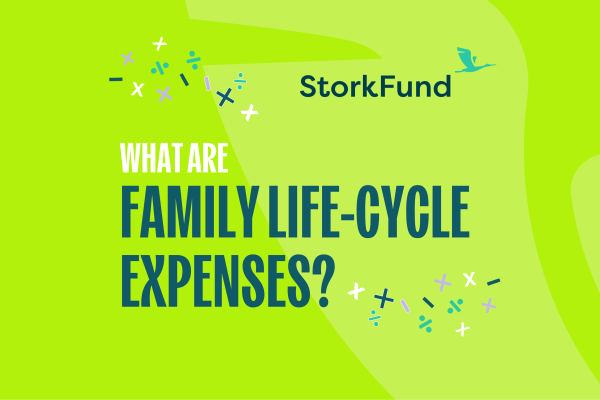Understanding Family Life-Cycle Expenses

Parenting costs as much as it rewards, earning you smiles while emptying your wallet. As we explore the various expenses incurred (and financial challenges faced) during a family’s growth and development, we’ll demonstrate how leveraging StorkFund helps working families navigate existing and future family life-cycle events and enables employers to minimize financial and productivity losses.
Key Insights
- The expenses associated with raising a family are extensive, including those relating to arrival and preparation, fertility and medical, leave and flexible working, childcare and enrichment and, ultimately, safeguarding of a family’s legacy.
- Families with particular needs, such as those requiring fertility treatments, those with multiple children, or those parenting children with special needs or within a single income household, may require additional financial resources to navigate these specific family life-cycle challenges.
- Employers of aspiring and working parents are significantly impacted by employees’ financial challenges, with experts estimating chronic financial stress results in employers incurring losses of $250 billion a year in reduced productivity alone.
- Opening a StorkFund, and leveraging the power of compounding, enables working families to build wealth while navigating family life-cycle expenses, and empowers employers to fuel the engines powering organizational success.
What ARE Family Life-Cycle Expenses?
“Family life-cycle expenses” refers to the costs incurred while having and raising a family, with the nature of these costs evolving with each phase of a family’s growth and development.
Pre-Family Planning Expenses
 Preparing for the arrival of a new family member, particularly for families expanding for the first time, is often a significant financial challenge; easily requiring parents to expend thousands of dollars, even with insurance coverage offsetting some, or all, of these expenses.
Preparing for the arrival of a new family member, particularly for families expanding for the first time, is often a significant financial challenge; easily requiring parents to expend thousands of dollars, even with insurance coverage offsetting some, or all, of these expenses.
Prenatal Care
Medical visits and screenings, nutritional programs, medications and vitamins, educational and counseling classes, management of pre-existing and emerging conditions, fetal health monitoring, and numerous other related expenses.
Arrival and Preparation
Cribs, bassinets, changing tables, strollers, car seats, bottling and lactation supplies, baby clothing, home proofing and safety gear, together with other nursery items and essentials.
Fertility Treatments
Reproductive support is critical for the 12.8% of men and 15.4% of women, ages 25 – 49, experiencing difficulty conceiving or sustaining a pregnancy. Additionally, members of the LGBTQIA+ community, as well individuals choosing to parent on their own, may also require reproductive support to expand their families. Fertility procedures, such as IVF, IUI, ICSI, egg and sperm freezing and storage, fertility and genetic testing, and surrogacy, may range from $30,000 (the potential cost of one IVF cycle) to $150,000 or more (the potential cost of a gestational surrogate).
Adoption
Application, agency, legal support, home study, birth parent, travel, and an array of other expenses incurred in connection with an adoption of one of the hundreds of thousands of children adopted each year, whether privately or through foster care.
Early Parenthood
The thrill of expanding one’s family may soon be tempered by the tough reality of balancing the family’s increasing financial needs while experiencing a potential reduction in household income.
 Childbirth
Childbirth
The average cost of childbirth, including pregnancy, delivery, and postpartum care, is $18,865 (or $26,280 in the event of a birth by cesarean); thankfully, for those with insurance, the average out-of-pocket cost is reduced to a “few” thousand dollars: $2,854 (or $3,214 in the event of a birth by cesarean).
Maternity or Paternity Leave
As only 23% of employees are eligible to receive paid parental leave, the overwhelming majority of working parents face the unfortunate and harsh reality of returning to the workforce shortly after welcoming a new infant home; whether or not the return to work serves their (or their infant’s) long-term well-being. Those opting to take parental leave typically shoulder this reduction in household income by borrowing from the future, withdrawing funds from emergency savings or, even worse, retirement accounts.
Postpartum Support
The nature of support required will vary across families and may include:
- Lactation support, to provide mothers with breastfeeding and latching techniques, milk supply assistance, and pain and discomfort guidance.
- Night nursing support, to provide overnight infant care and permit parents to rest and recover, particularly during the first few weeks after birth when sleep deprivation is common.
- Doula support, to provide both emotional and practical support, as well as newborn care guidance.
- Mental health support, to engage professionals specializing in the diagnosis and management of postpartum care, depression and anxiety.
- Physical recovery support, to engage professionals specializing in pelvic floor therapy, postpartum exercise guidance, and bodywork (such as massage therapy) to support a new mother’s physical recovery after childbirth.
- Educational support, to provide information and resources regarding newborn care, infant sleep routines, and infant development.
- Nutritional support, to provide mothers and infants with the nutritional guidance and resources essential for recovery and breastfeeding.
- Home support, to assist with household chores, errands, or other day-to-day activities, reducing parental stress and providing parents the opportunity to focus on family bonding and childbirth recovery.
Early Childhood and School Age
As parents return to work and children enter nurseries and schools, new expenses emerge.
Childcare

Childcare is often the single largest expense for families: Infant care (up to 18 months) is the most expensive form of childcare, with a 2023 average of $22,350 per child per year, compared to $17,800 for toddler care and $13,950 for preschooler care. Emergency / drop-in childcare, and before- and after-school care programs (which provide care for school-aged children outside of regular school hours, often at a school or a nearby facility), may be additional expenses incurred by working parents. The staggeringly high costs are (unsurprisingly) unaffordable for many working parents, leading 43% of working mothers to exit the labor force to avoid incurring them.
Education and Enrichment
Tuition and enrollment, back-to-school supplies and ongoing materials (including technological supplies such as laptops and tablets), uniforms, transportation, tutoring and educational support services, field trips, testing and examination, and experiential learning opportunities, such as holiday learnings, enrichment camps, and language or immersion programs.
Funds may also be required for fees, uniforms, equipment, supplies, gear, lessons, and travel for sports teams, clubs, and a range of arts and extracurricular programs.
Health and Wellness
Regular medical and dental visits and screenings, vaccinations, unexpected medical needs (such as braces), early intervention services, special needs wellness programs, therapeutic programs (such as speech or physical therapy), and potential emergency care, are common (and potentially recommended) family life-cycle expenses during these years.
Teenage
Teenagers bring their own opportunities for parental joy and unique financial considerations, namely:
Higher Education Planning
Saving for college tuition or vocational training, with an average cost of college tuition (excluding room and board and educational supplies) of $42,162 for private colleges, $23,630 for public out-of-state colleges, and $10,662 for public in-state colleges. Ironically, the magnitude of these costs mirror the childcare expenses previously incurred, especially if a family has not previously funded a 529 Savings Plan, Education Savings Account, or Custodial Account to navigate these expenses.
Some Families Encounter Extra Hurdles
While navigating family life-cycle expenses is indeed challenging, it’s important to highlight families may experience heightened financial challenges particular to their family dynamics. For example:
- Families with two or more children may incur early parenthood and school age expenses at the same time or may incur early parenthood expenses for several children, in succession, for an extended period of time.
- Single-parent, LGBTQIA+, blended, extended, multi-generational, and kinship families may encounter specific challenges relating to their familial composition and/or expansion opportunities.
- Family members with special needs, diverse abilities, developmental challenges, and/or disabilities, may require families to incur additional expenses to secure the specialized support the family requires.
Families Power Organizations
Unsurprisingly, organizations are significantly impacted by the mental and financial outcomes resulting from these financial challenges.
When new parents return to work sooner than advised, for example, or prematurely withdraw funds from emergency saving or retirement accounts to fund otherwise unpaid parental leave, the resulting mental health and chronic financial stresses often drive losses in productivity, increased absenteeism, and/or increased turnover. Working parents who don’t have the financial resources required to secure reliable childcare or to maintain a sufficiently adequate household income while working a flexible schedule, often experience heightened unplanned absenteeism. Indeed, a Cornell University research group previously reported absenteeism due to breakdowns in childcare arrangements amounts to $1,700 per employee, with the average employee missing a staggering 8 to 9 days of work per year due to these breakdowns. Reduced employment engagement and morale are also likely outcomes when parents are financially overburdened and unsupported, accelerating turnover rates. To compound these productivity, absenteeism, engagement, and turnover concerns, the cumulative effects of these challenges may lead to increased health-related costs for employers, further highlighting the need for organizations to adopt comprehensive family support policies.
Manage Family Life-Cycle Expenses With StorkFund
![]() StorkFund is designed to empower parents and aspiring parents to effortlessly save for and manage family life-cycle expenses, leveraging the power of compounding and enabling employees to save directly from their paychecks, in a high-yield savings and/or investment account, with contributions matched by their employer. With a StorkFund:
StorkFund is designed to empower parents and aspiring parents to effortlessly save for and manage family life-cycle expenses, leveraging the power of compounding and enabling employees to save directly from their paychecks, in a high-yield savings and/or investment account, with contributions matched by their employer. With a StorkFund:
- Employees Contribute to their StorkFund each paycheck, and
- Employers Match some or all of their employees’ contributions within each paycheck, with
- Investment and Savings accounts available for employees to select, in line with their financial goals and family needs. Funds are
- Accessible as Needed and reserved for family life-cycle expenses, including those referenced, above, and provided
- Alongside Community, resources, and exclusive discounts provided by trusted fertility, childcare, and other family life-cycle providers.
With StorkFund, parents and aspiring parents proactively contribute towards family life-cycle expenses, thereby increasing long-term financial security, minimizing financial stress, and securing peace of mind; bringing their best, most whole, and productive selves to all areas of life, whether at home or at the workplace, as a result.
By understanding, and preparing for, family-life cycle expenses, parents and aspiring parents focus on the things which truly matter: Having and raising a family in a nurturing and supportive environment.
Plan for your (or your organization’s) success at every stage of a family’s life-cycle journey and start saving today with StorkFund.